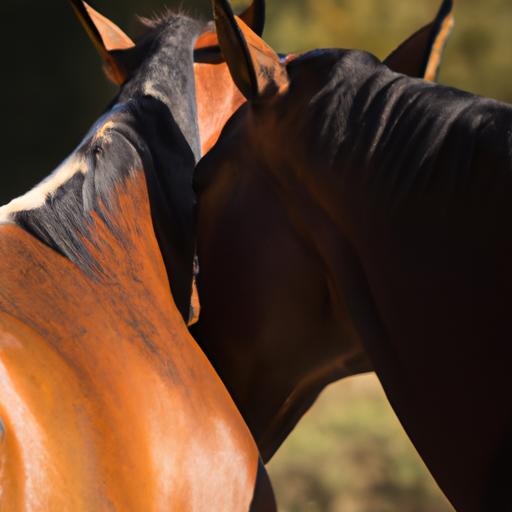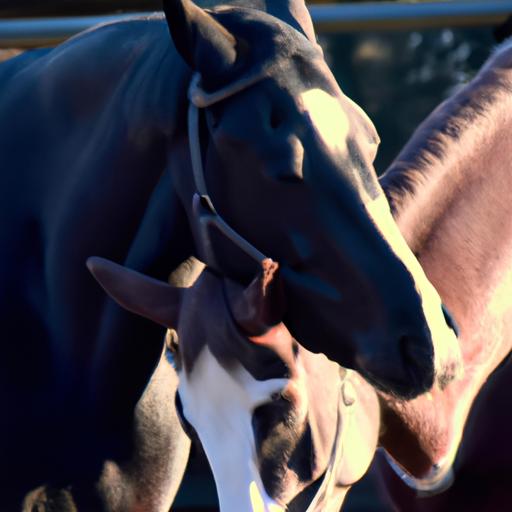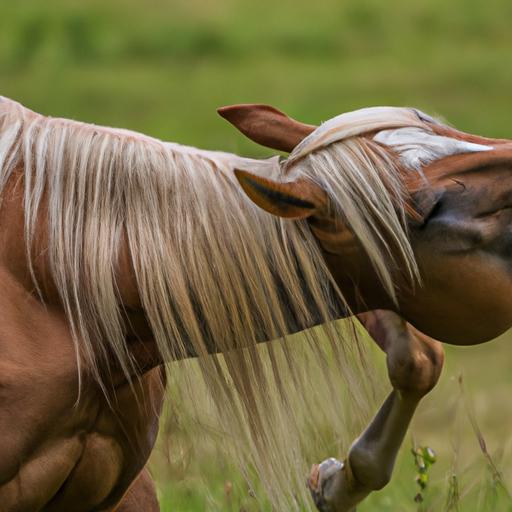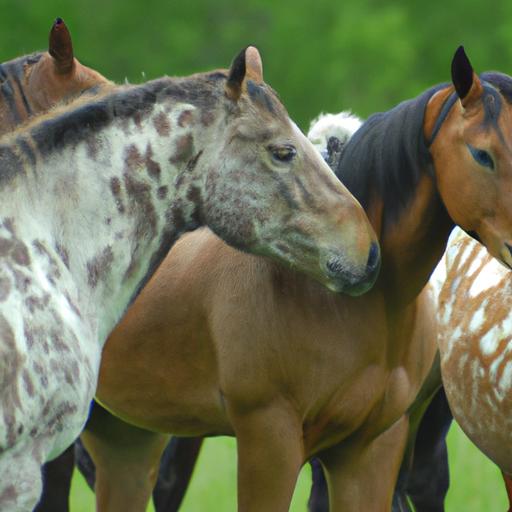Unlock the secrets of horses grooming behavior, optimize their welfare & performance. Learn how to observe, assess & enhance their natural grooming instincts.
Introduction

When it comes to caring for our beloved horses, understanding their grooming behavior is of utmost importance. Grooming is not only about keeping their coats clean and shiny; it plays a vital role in their overall well-being and performance. In this article, we will delve into the fascinating world of horse grooming behavior, exploring its definition, significance, and how we can optimize it to ensure our horses thrive.
Horse grooming behavior refers to the natural actions and instincts exhibited by horses to maintain their coat and skin health. It encompasses activities such as mutual grooming between herd members, self-grooming, and interaction with caretakers during grooming sessions. These behaviors are deeply rooted in their evolutionary history and serve various purposes beyond hygiene.
Understanding horse grooming behavior is essential for several reasons. Firstly, it allows us to gain insight into their social dynamics and herd hierarchy. Mutual grooming plays a crucial role in bonding between horses, promoting trust and establishing a sense of security within the group. By observing their grooming behavior, we can better comprehend their social interactions and overall well-being.
Additionally, grooming behavior offers valuable clues about a horse’s physical and mental state. Changes in grooming habits, such as excessive or reduced grooming, can indicate underlying health issues or stress. Monitoring and assessing their grooming behavior helps us identify potential problems early on, allowing for prompt intervention and appropriate care.
In this article, we will explore the factors that influence horse grooming behavior, techniques for observing and evaluating it, and strategies to optimize grooming sessions for the welfare and performance of our equine companions. By understanding and nurturing their natural grooming instincts, we can create a harmonious bond with our horses while ensuring their physical and emotional well-being.
So, let’s embark on this journey together, unraveling the secrets of horse grooming behavior and discovering ways to enhance the lives of our magnificent equine friends. Join me as we delve into the captivating world of horse grooming and unlock its potential for better horse welfare and performance.
Understanding Horse Grooming Behavior

Natural Behavior and Instincts
To truly grasp the essence of horse grooming behavior, we must delve into their innate instincts and natural behavior. Horses are social animals with a hierarchical structure within their herds. Grooming plays a pivotal role in maintaining social bonds and establishing trust among herd members.
Horses have an inherent desire to groom and be groomed. Mutual grooming, also known as allogrooming, is a common sight in herds, where horses take turns using their teeth and lips to gently nibble and scratch each other’s coats. This behavior not only helps in removing dirt and debris but also serves as a form of social interaction and communication.
Self-grooming, or autogrooming, is another significant aspect of their natural behavior. Horses use their teeth, lips, and even their hooves to scratch hard-to-reach areas, remove loose hair, and stimulate blood circulation in their skin. This self-grooming behavior not only aids in maintaining coat health but also provides a sense of comfort and relaxation to the horse.
Contribution to Social Bonding and Herd Dynamics
Grooming behavior plays a crucial role in fostering social bonds and establishing a harmonious herd dynamic. Through mutual grooming, horses engage in a reciprocal act of care, strengthening their social connections and reinforcing the herd’s unity. It is a display of trust, cooperation, and social acceptance within the group.
Moreover, grooming behavior serves as a means of communication among horses. It allows them to convey messages of trust, submission, and camaraderie. By engaging in mutual grooming, horses establish and maintain their position within the herd’s social hierarchy. It is a way for dominant horses to assert their authority and for subordinate horses to show respect and deference.
Understanding these natural grooming behaviors helps us appreciate the significance of grooming in the lives of our horses. By recognizing the importance of grooming for social bonding and herd dynamics, we can create an environment that encourages and supports these natural behaviors. In the following sections, we will explore the factors that influence grooming behavior and how we can optimize it for the well-being and performance of our horses.
Factors Influencing Horse Grooming Behavior

Grooming behavior in horses can be influenced by various factors, ranging from environmental conditions to the interactions they have with their caretakers. Understanding these factors is crucial for optimizing grooming sessions and ensuring our horses feel comfortable and engaged. Let’s explore two key influences on horse grooming behavior: environmental factors and the role of caretakers.
Environmental Factors and Grooming Behavior
The environment in which horses are groomed plays a significant role in shaping their grooming behavior. Access to suitable grooming tools and facilities is essential for encouraging natural grooming instincts. Providing horses with high-quality brushes, combs, and grooming equipment not only enhances their grooming experience but also helps maintain their coat health.
Creating a calm and comfortable grooming environment is also crucial. Horses are highly perceptive animals and can be sensitive to their surroundings. Loud noises, unfamiliar scents, or crowded spaces may cause stress or anxiety, affecting their willingness to engage in grooming behavior. By ensuring a peaceful and well-organized grooming area, we can promote a positive grooming experience for our equine companions.
The Role of Horse Caretakers
The interactions between horse caretakers and their horses can greatly influence grooming behavior. Horses are social animals that thrive on trust and positive relationships. When caretakers approach grooming sessions with patience, kindness, and respect, horses are more likely to engage in grooming behavior willingly.
Caretakers can stimulate grooming behavior by using gentle strokes and movements that mimic natural grooming actions. By paying attention to areas horses enjoy being groomed, such as the withers or the base of the tail, caretakers can encourage horses to actively participate in the grooming process.
Conversely, negative experiences with caretakers can inhibit grooming behavior. Rough handling, forceful restraint, or rushed grooming sessions can create stress and cause horses to become reluctant or resistant to being groomed. Building trust and fostering a bond of mutual respect and understanding is key to encouraging horses to engage in grooming behavior willingly.
By considering the environmental factors that affect grooming behavior and cultivating positive interactions with our horses during grooming sessions, we can create an environment that promotes their well-being and encourages their natural grooming instincts. In the next section, we will explore techniques for observing and assessing horse grooming behavior, allowing us to better understand our horses’ needs and ensure their overall health and happiness.
Observing and Assessing Horse Grooming Behavior
Understanding and assessing horse grooming behavior is crucial for ensuring their well-being. By observing and evaluating their grooming habits, we can gain valuable insights into their physical and mental state. Let’s explore some techniques for effectively observing and assessing horse grooming behavior and learn how to identify abnormal behaviors that may indicate underlying health or behavioral issues.
Techniques for Observing and Evaluating Grooming Behavior in Horses
-
Visual Observation: One of the simplest and most effective techniques is to visually observe horses during their grooming sessions. Pay attention to their body language, facial expressions, and overall demeanor. Are they calm and relaxed or displaying signs of discomfort or agitation? Take note of their grooming patterns, the areas they focus on, and the duration of their grooming sessions.
-
Record Keeping: Keeping a grooming journal can be immensely helpful in tracking and evaluating grooming behaviors over time. Note down any changes in their grooming routine, such as increased or decreased grooming frequency, specific areas of focus, or any unusual behaviors observed. This will provide valuable information for identifying patterns or deviations from their normal grooming habits.
Identifying Abnormal Grooming Behaviors
-
Excessive Grooming: While grooming is a natural behavior, excessive or obsessive grooming can be a cause for concern. Excessive grooming, particularly in specific areas, may indicate skin conditions, allergies, or underlying stress. Look for signs of hair loss, skin irritation, or self-inflicted wounds resulting from excessive grooming.
-
Reduced Grooming: On the other hand, a sudden decrease in grooming behavior can also be indicative of underlying issues. Horses that exhibit reduced grooming may be experiencing pain, discomfort, or changes in their mental well-being. Pay attention to changes in their grooming routine and investigate potential causes such as injuries, illness, or changes in their environment.
By carefully observing and assessing horse grooming behavior, we can detect early signs of discomfort or distress, allowing us to address any underlying health or behavioral issues promptly. Regular monitoring and record-keeping enable us to track changes in their grooming habits and take appropriate action when necessary.
Remember, every horse is unique, and their grooming behaviors may vary. It is essential to establish a baseline for each individual horse and be attentive to any deviations from their normal grooming routines. By doing so, we can provide the necessary care and support to promote their overall well-being and ensure a healthy and fulfilling grooming experience.
Optimizing Horse Grooming Behavior for Welfare and Performance
Grooming sessions are not just about maintaining a horse’s physical appearance; they also provide an opportunity to enhance their overall welfare and performance. By optimizing the grooming experience, we can create a positive and relaxing environment that promotes the natural grooming behaviors of our equine companions. Let’s explore some effective strategies to achieve this:
5.1 Providing Suitable Grooming Tools and Equipment
To facilitate natural grooming behaviors, it is crucial to provide horses with suitable grooming tools, brushes, and equipment. Different brushes and tools cater to specific grooming needs, such as removing dirt, shedding hair, or massaging their muscles. Invest in high-quality grooming supplies that are comfortable for both you and your horse. Gentle grooming tools with soft bristles or rubber tips are ideal for promoting relaxation during grooming sessions.
5.2 Creating a Positive and Stress-Free Grooming Environment
The grooming environment plays a significant role in how horses perceive and respond to grooming sessions. Create a calm and stress-free atmosphere by choosing a quiet location away from distractions. Ensure the grooming area is well-lit and well-ventilated, providing a comfortable temperature for your horse. Soft music or soothing sounds can also help create a relaxing ambiance.
Building a positive association with grooming is essential. Start grooming sessions with gentle strokes and gradually increase intensity as your horse becomes more comfortable. Reward their cooperation with verbal praise, gentle pats, or small treats. By associating grooming with positive experiences, you can foster a sense of trust and relaxation in your horse.
5.3 Techniques for Encouraging Grooming Behavior and Promoting Relaxation
Encouraging horses to engage in grooming behavior requires patience and understanding. Begin by observing their natural preferences and responses during grooming. Some horses may enjoy being groomed in specific areas, such as their neck or withers, while others may prefer a full-body grooming session. Respect their individual preferences and adapt your grooming techniques accordingly.
Incorporate relaxation techniques during grooming sessions to promote a sense of calm. Use long, sweeping strokes that mimic mutual grooming, which can trigger a relaxation response. Pay attention to their body language and adjust your approach accordingly. If your horse shows signs of discomfort or tension, take a step back and reassess the situation. Remember, grooming should be a pleasurable experience for both you and your horse.
In conclusion, optimizing horse grooming behavior is essential for their welfare and performance. By providing suitable grooming tools, creating a stress-free environment, and employing techniques that encourage relaxation, we can enhance the grooming experience for our equine companions. Remember to tailor your approach to each horse’s individual preferences and needs, and always prioritize their comfort and well-being. With these strategies in place, you can transform grooming sessions into moments of bonding, relaxation, and mutual enjoyment.


